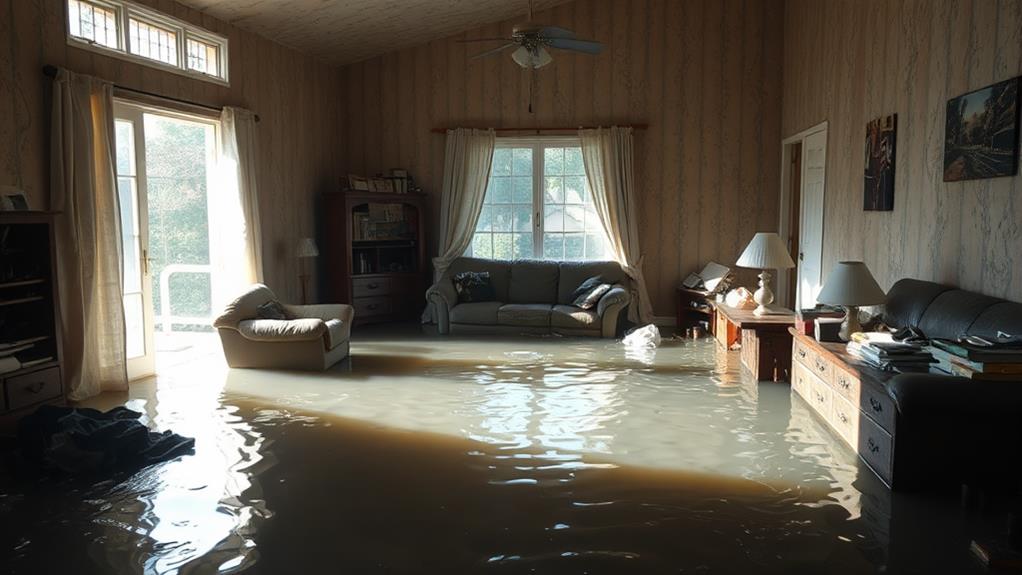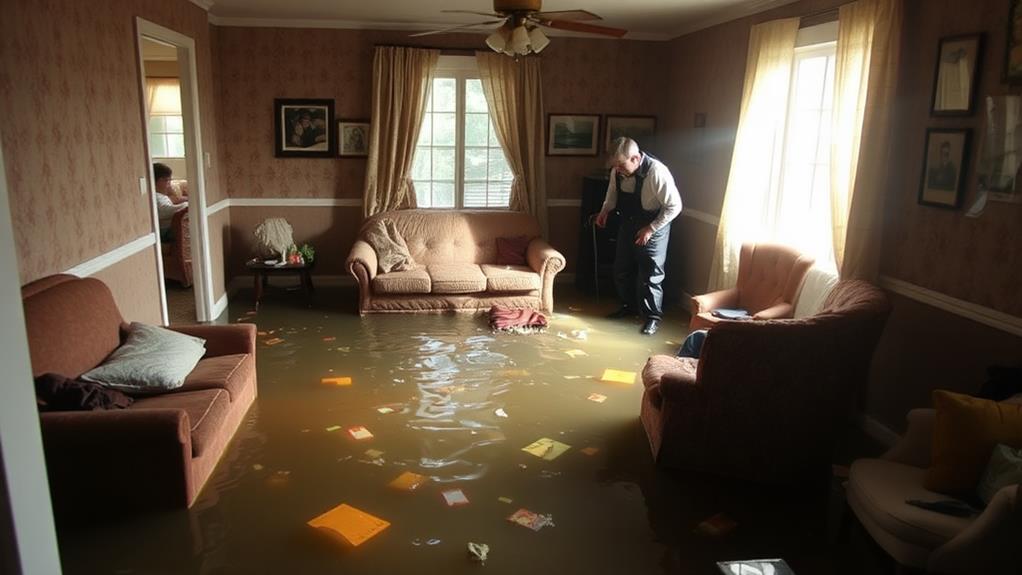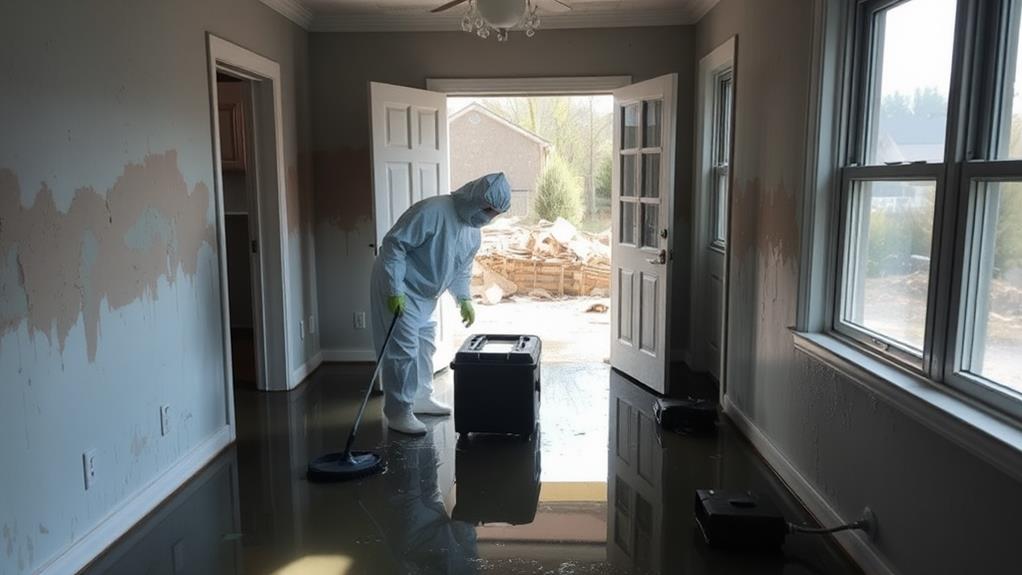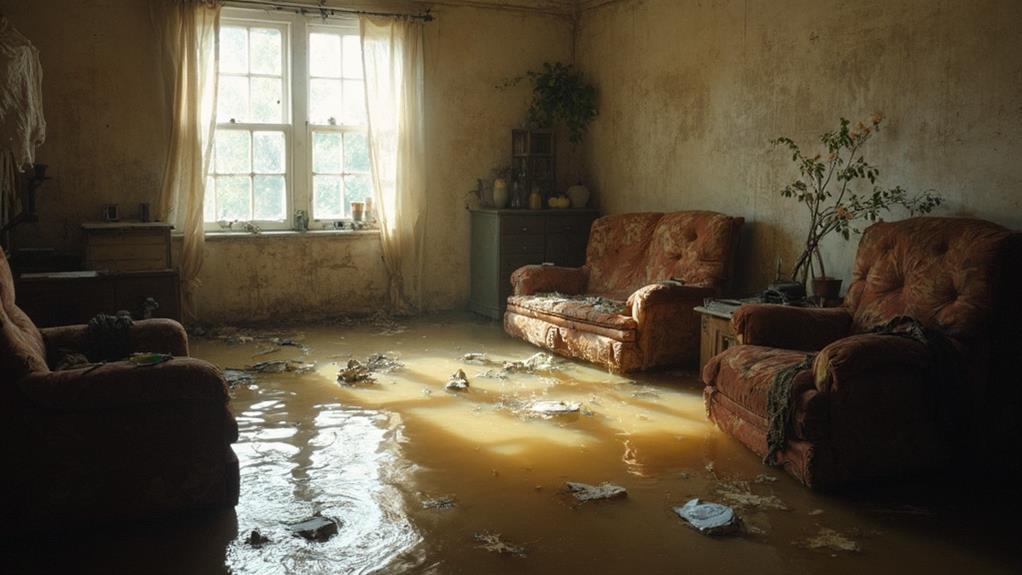When dealing with standing water in your home after a storm, swift action is crucial. First, ensure safety by turning off electricity and wearing protective gear. Assess the extent of flooding and document damage for insurance purposes. Remove water using pumps, wet vacuums, or squeegees, working from the highest to lowest points. Promote drying with fans and dehumidifiers, and monitor hidden moisture. Clean and disinfect affected areas thoroughly with detergent and bleach solutions. To prevent future incidents, address the water intrusion source, maintain exterior features, and install sump pumps. By following these steps, you can minimize damage and protect your home's integrity. The following sections provide more detailed guidance for each step of the process.
Assess the Situation

A flooded home presents an immediate challenge that requires swift action. The first step in addressing standing water is to assess the situation thoroughly.
Begin by ensuring your safety and that of your family. Do not enter a flooded area if there's a risk of electrical hazards or structural damage.
Once it's safe to proceed, determine the extent of the flooding. Measure the water depth in different areas of your home and identify the source of the water. This information will help you decide whether to handle the situation yourself or call in professionals. Consider the type of water involved: clean water from pipes, gray water from appliances, or black water from sewage, as each requires different handling.
Assess the affected materials and belongings. Some items may be salvageable with proper cleaning, while others might need to be discarded. Document the damage with photographs and videos for insurance purposes. Evaluate potential health risks, such as mold growth or contamination. This initial assessment will guide your next steps and help you prioritize tasks in the cleanup process.
Safety First
With the situation assessed, prioritizing safety becomes paramount. Before attempting to remove standing water, ensure the electricity is turned off at the main breaker to prevent electrocution risks. If you're unsure about the electrical system's status, consult a professional electrician.
Wear appropriate personal protective equipment, including waterproof boots, rubber gloves, and eye protection. Be aware that floodwater may contain harmful bacteria, sewage, or chemical contaminants, so avoid direct contact with skin or eyes.
Inspect the structural integrity of your home before entering. Look for signs of foundation damage, cracks in walls, or sagging ceilings that could indicate potential collapse. If you suspect structural issues, wait for professional assessment before proceeding. Use caution when walking on wet surfaces, as they can be extremely slippery.
If possible, work in pairs or teams to ensure someone can call for help if needed. Keep children and pets away from affected areas to prevent accidents or exposure to contaminated water. Finally, have a well-stocked first aid kit readily available in case of minor injuries during the cleanup process.
Remove Standing Water

Promptly removing standing water is crucial to minimize damage and prevent mold growth. Begin by using a sump pump, wet vacuum, or submersible pump to extract large volumes of water. For smaller amounts, mops, buckets, and towels can be effective. Always follow manufacturer instructions when using electrical equipment and ensure it's properly grounded.
Start from the highest point of flooding and work your way down, paying special attention to basements and crawl spaces where water tends to accumulate. Remove water from furniture, carpets, and other porous materials. If possible, move affected items outdoors to dry.
For hard surfaces, use squeegees to push water towards drains or exits. Open windows and doors to improve air circulation, which aids in drying. If weather permits, use fans to increase airflow. Dehumidifiers can also help remove excess moisture from the air.
Be thorough in your efforts, as even small amounts of standing water can lead to significant problems if left unaddressed. Remember to document the damage for insurance purposes before and during the water removal process.
Dry and Dehumidify
After removing standing water, the next critical step is to thoroughly dry and dehumidify the affected areas. This process is essential to prevent mold growth, structural damage, and lingering odors. Begin by opening windows and doors to allow for air circulation, if weather permits. Use fans strategically to promote airflow and accelerate drying.
Dehumidifiers are crucial tools in this phase. Place them in the most severely affected rooms, ensuring they're sized appropriately for the space. Empty dehumidifier reservoirs regularly or set up continuous drainage systems for efficiency. Monitor humidity levels with a hygrometer, aiming to maintain relative humidity below 50%.
For hidden moisture in walls, floors, or ceilings, consider using specialized equipment like moisture meters or infrared cameras. These tools can help identify areas that require additional attention. In severe cases, remove baseboards, drill small holes in walls, or use injection drying systems to circulate dry air within wall cavities.
Continue the drying process for several days, even after surfaces appear dry. Moisture can linger in building materials, so thorough drying is crucial for preventing long-term issues. Document the drying process for insurance purposes and consider professional assistance for extensive water damage.
Clean and Disinfect

Once the affected areas have been thoroughly dried, cleaning and disinfecting become paramount to ensure a safe and healthy living environment. Begin by removing any remaining debris and dispose of items that cannot be salvaged. Scrub all surfaces with a mixture of hot water and detergent to remove dirt, grime, and potential contaminants.
After cleaning, disinfection is crucial to eliminate harmful bacteria, mold, and other pathogens. Use a solution of one cup of bleach per gallon of water for most surfaces. For porous materials like wood, a specialized fungicide may be necessary. Pay particular attention to areas prone to moisture retention, such as corners, crevices, and joints.
Wear protective gear, including gloves, goggles, and a respirator, during the cleaning and disinfecting process. Ensure proper ventilation by opening windows and using fans. For extensive damage or if mold growth is significant, consider hiring professional remediation services.
Once disinfected, allow surfaces to air dry completely. Clean and disinfect all tools and equipment used in the process to prevent cross-contamination. Finally, conduct a thorough inspection to ensure all affected areas have been properly treated and no signs of mold or water damage remain.
Prevent Future Water Damage
Having addressed the immediate aftermath of standing water, it's crucial to implement preventive measures to avoid future water damage. Begin by identifying and addressing the source of the water intrusion, whether it's a leaky roof, faulty plumbing, or poor drainage around your home's foundation.
Regularly inspect and maintain your home's exterior, including the roof, gutters, and downspouts. Ensure proper grading around your house to direct water away from the foundation. Install and maintain sump pumps in basements or crawl spaces prone to flooding. Consider applying waterproof sealants to walls and floors in vulnerable areas.
Upgrade your home's plumbing system if necessary, replacing old or damaged pipes. Install water detection devices near potential problem areas like water heaters, washing machines, and dishwashers. These devices can alert you to leaks before they cause significant damage.
Develop an emergency response plan for future water incidents, including a list of important contacts and steps to take. Keep essential supplies on hand, such as sandbags, plastic sheeting, and a water pump. Finally, review your insurance coverage to ensure adequate protection against water damage and flooding.
Frequently Asked Questions
How Long Can Standing Water Remain Before Causing Permanent Structural Damage?
The duration standing water can remain before causing permanent structural damage varies. Generally, within 24-48 hours, mold growth can begin. Significant structural issues may arise after several days to weeks of continuous water exposure.
Can I Use My Regular Vacuum Cleaner to Remove Standing Water?
No, you should not use a regular vacuum cleaner to remove standing water. This can damage the vacuum and potentially cause electrical hazards. Instead, use a wet/dry vacuum, pump, or professional water extraction equipment for safe and effective removal.
What Should I Do With Water-Damaged Furniture and Belongings?
Studies show 60% of water-damaged furniture can be salvaged with proper care. For water-damaged belongings, act quickly: remove items from wet areas, clean and disinfect salvageable items, and dispose of irreparably damaged goods to prevent mold growth.
Are There Any Natural Methods to Absorb Moisture From the Air?
Several natural methods can effectively absorb moisture from the air. These include using silica gel packets, activated charcoal, rock salt, or baking soda. Additionally, houseplants like peace lilies and Boston ferns can help reduce humidity through transpiration.
How Can I Detect Hidden Moisture in Walls After Removing Visible Water?
To detect hidden moisture in walls, use a moisture meter for accurate readings. Visual inspection for discoloration, musty odors, or peeling paint can also indicate moisture issues. Thermal imaging cameras can reveal temperature differences caused by hidden dampness.
Conclusion
Ironically, the aftermath of a storm often brings more challenges than the tempest itself. While nature's fury subsides, the battle against standing water begins. This seemingly innocuous intruder can wreak havoc on homes, necessitating a meticulous approach to restoration. By adhering to proper assessment, safety protocols, water removal, drying, cleaning, and preventive measures, homeowners may find themselves better prepared for future deluges—a bittersweet victory in the face of nature's capricious moods.

